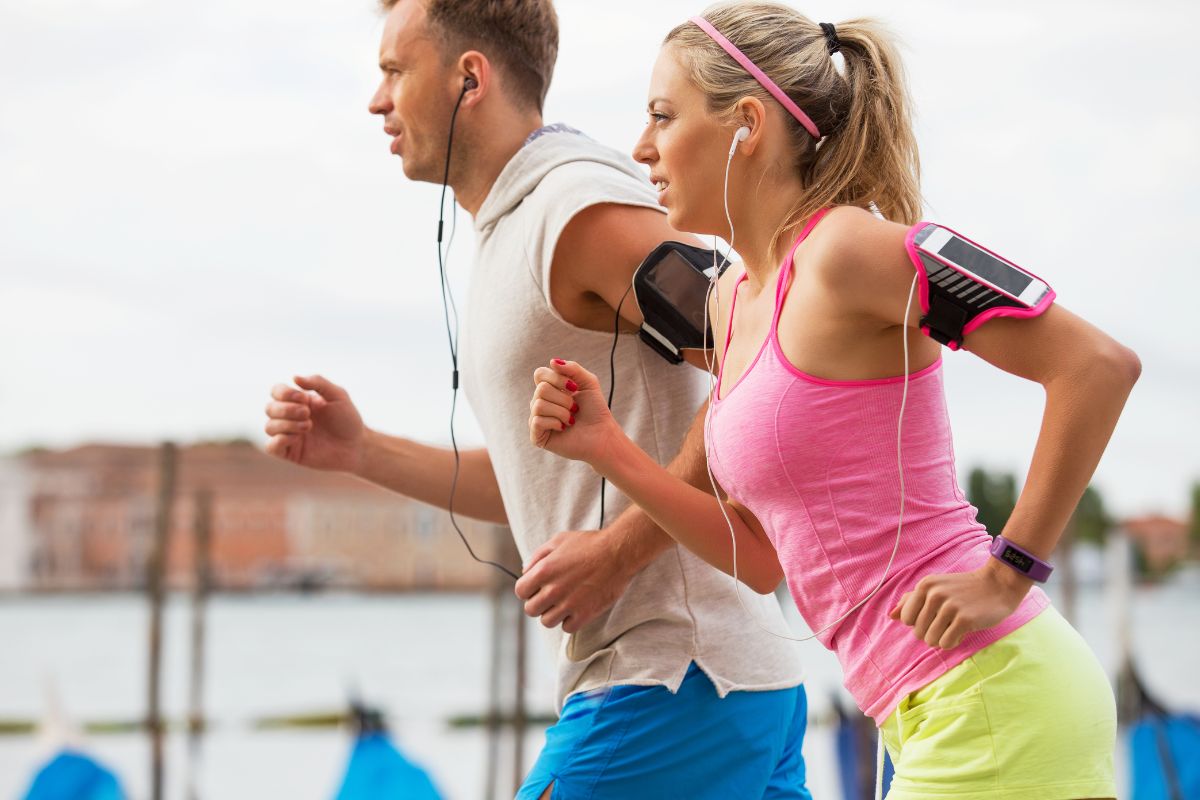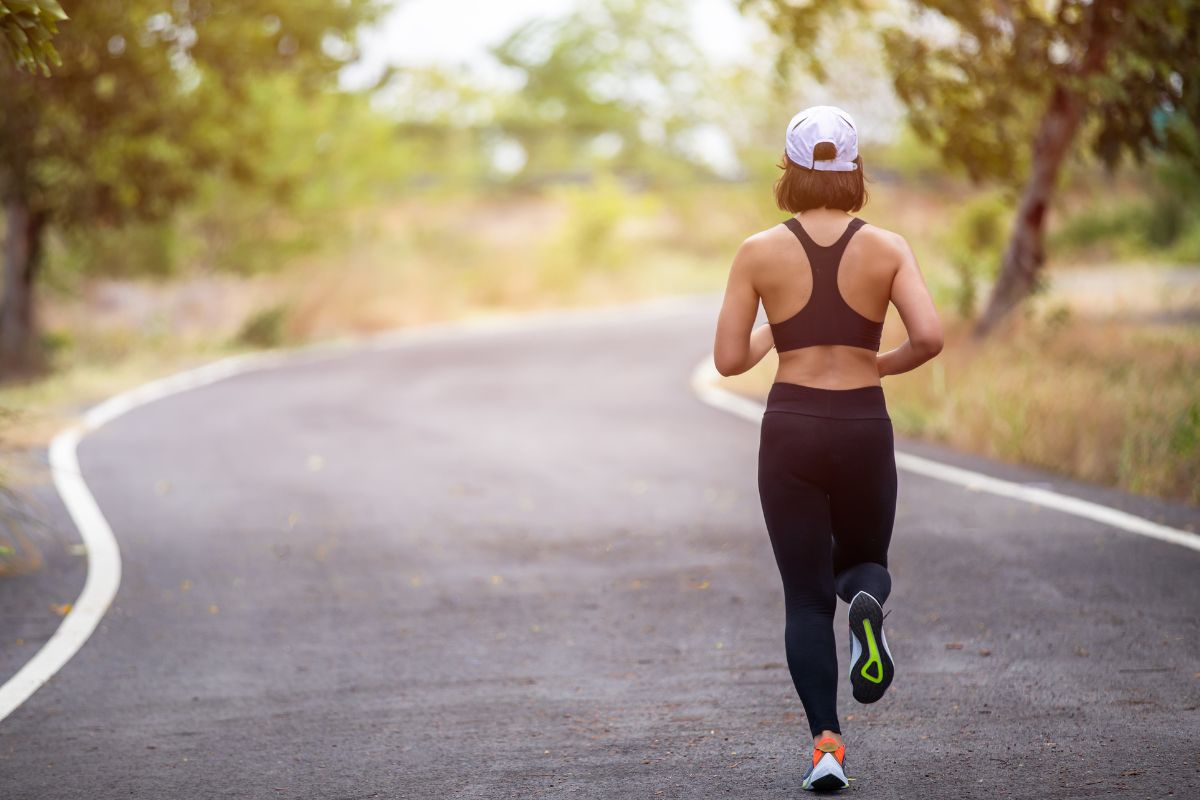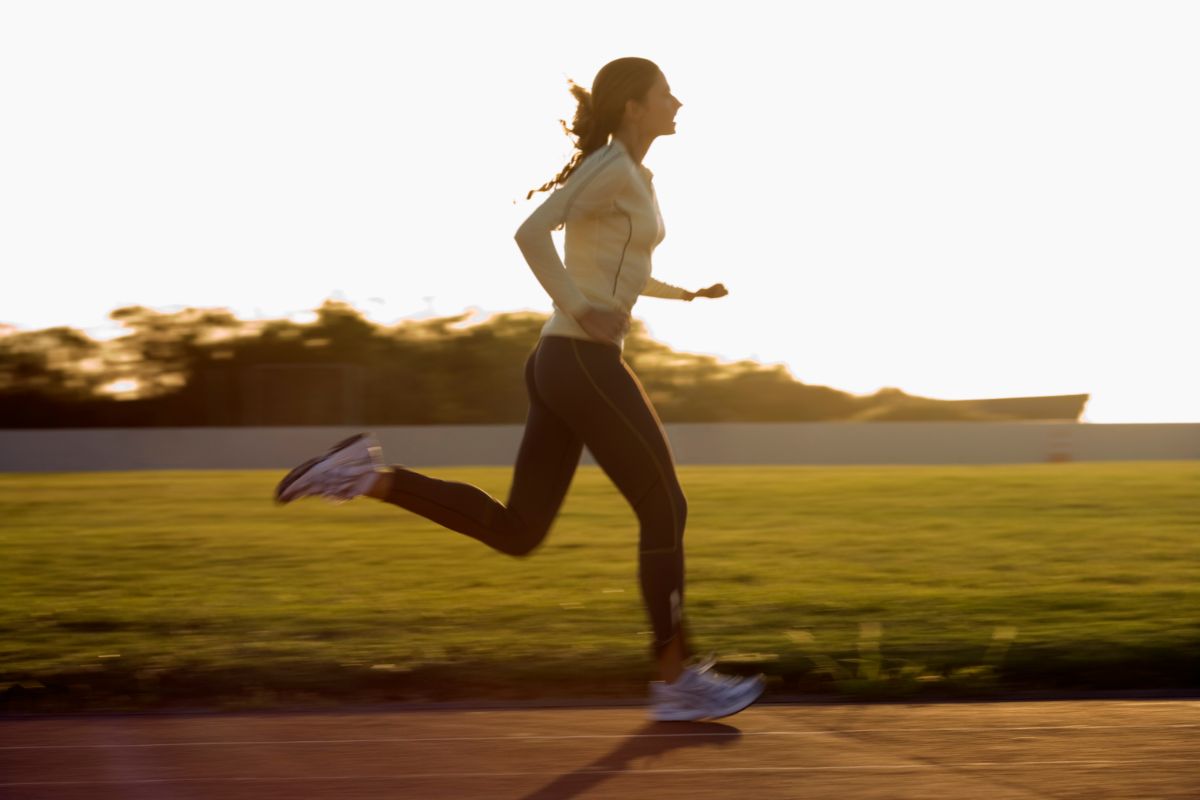No matter what sport you compete in, if you’re an athlete speed is something you’re always striving for.

If you’re a swimmer you want to achieve faster laps, while if you play a team sport such as soccer or football you want to be quick on your feet and agile.
Speed is something that athletes get a lot of praise for.
The need for speed is of course present in running too, with many runners wanting to know how they can run faster so they can shave off a couple extra seconds for their future workouts and races.
But while most people may never achieve the frankly superhuman speed of the world’s best professional runners like Usain Bolt, these incredible athletes can still motivate us and our running targets, especially if one of those goals is mastering the sprint.
Well, if you are interested in improving your sprint then this article is a great place to start!
We’ll break down the 4 main phases of sprinting mechanics, and even bust a few speed myths.
But first, let’s break down the difference between running and sprinting.
Running Vs Sprinting: What Is The Difference?
Running is an umbrella term, covering all sorts of gaits that create forward propulsion with your feet at a speed faster than walking.
So according to this definition, sprinting and jogging are types of running, but with obvious distinctions, such as the fact that jogging is a lot slower exercise than sprinting, and both require totally different methods of training.
Power Output
This is one of the most important factors that distinguishes running from sprinting.
When you run or jog, you’re running for longer periods of time than if you were sprinting, so how much power you generate would be much lower than the effort needed to sprint.
But in more scientific terms, you can compare how much oxygen is being consumed between someone running at a lighter pace and someone sprinting at an intense pace.
The American College of Sports Medicine has found that a person who weighs around 130 lbs ran 6mph (found to be a comfortable jogging pace) will likely consume around 2,140 mL of oxygen every minute, generating 719 watts of power.
But if that same person sprinted at around 15mph then their oxygen consumption would double to 5,050 mL every minute and they would generate about 1,690 watts of power.
So the difference between the two is startling!
Energy Systems
So as we can see, sprinting is an intense exercise that is demanding of oxygen, and cannot be kept up for long durations.
Sprinting and running demand different things from the human body and you need to draw from different kinds of energy to keep your muscles forward and keep up that forward propulsion.
When you’re running you’re doing so over longer distances and durations, requiring you to ration out your energy to take you through your run.
Your body turns to slow twitch muscle fibers and uses its aerobic system to sustainably produce and consume oxygen.
Meanwhile, sprinting is a shorter workout that is more intense.
Therefore you don’t generate aerobic energy fast enough to sustain such intense activity.
Instead your body will rely on its anaerobic system and fast twitch muscle fibers to utilize glycogen stores so it can quickly release bursts of energy.
Form
Lastly, we’ll be talking about the most visually distinct factor in the difference between running and sprinting, and that is form.
When discussing the correct form for long distance running, we focus on the optimal posture and joint angles that help to preserve energy and absorb shock over an extended period of time.
Runners will have fewer hip flexion and triple extension than sprinters during the propulsion stage of their gait.
Their stance times will be longer and they’ll usually demonstrate deeper ankle, hip, and knee flexion during the mid-stance and peak knee flexion phases.
In theory, this may be because long distance running requires a greater amount of shock absorption to protect your joints during repetitive, sustained impacts.
When it comes to sprinting and form meanwhile, there is more of an emphasis on aerodynamics, and the main focus will be to achieve the biomechanics for faster, powerful strides, including increased hip flexion/knee drive, and lower flexion in the ankles, hips, and knees during mid-stance, and exaggerations of triple extension to create more power for optimal propulsion.
You may notice sprinters sprinting with higher degrees of shoulder extension and flexion, as well as faster arm swing to make up for the forward velocity of their movements.
Can You Teach Speed?

You may have heard that speed can’t be taught, and we’re here to tell you that isn’t true.
By figuring out the right technique and putting in the training you can improve your speed.
Still, it’s important not to underestimate your genetic make-up when it comes to what you can achieve with your performance, and your ability to compete in elite competitions.
Still, even the most talented athletes have to perfect a technique and spend hours and hours training.
It’s helpful to think of sprinting as learning a motor skill.
Motor learning or ‘motor skill learning’ is normally defined as “the process by which movements are executed more quickly and accurately with practice.”
So a good example would be a pitcher perfecting their curveball, or a basketball player practicing free throws.
We can also apply this to sprinting, and train our nervous systems and muscles to respond and move in a way that will produce a good amount of speed.
This approach is wildly different to more traditional forms of sprint training.
A lot of athletes and coaches work on the premise that speed is developed by dedicating a lot of time to sprinting.
On the surface this makes sense.
After all, with endurance running and fitness, the more miles you run and the more training you do usually leads to improved aerobic capacity and faster running times.
But sprinting isn’t just about running faster, because there is only so much your speed can approve with repetition.
This is because the technique and biomechanics of sprinting is very distinct to running, as we have already seen.
After all, optimal sprinting technique and posture isn’t something that comes naturally and needs to be developed.
At a surface level, optimal running and sprinting have some things in common.
For both you need a neutral pelvis, to keep your head looking forward, to stand up tall, and for your foot strike to be underneath the center of mass.
However, if you look a bit deeper, then the differences become obvious.
Technique is one of the most crucial differences between running and sprinting.
For example, the angles of your body, the ground contact time, how you move your arms and the foot strike are completely different.
Attempting to improve your speed without understanding and practicing accurate sprinting techniques will just get you into bad habits.
Faster sprinting is about applying the most amount of force you can to the ground.
The more force you apply to the ground, the faster you can go.
The fastest sprinters produce 5 times more vertical force into the ground than slower sprinters do.
For example, researchers found that Usain Bolt is capable of producing over 1000 lbs of force down to the ground.
The 3 ways to improve force application are correct sprinting form/posture, proper sprinting rhythm, and proper sprinting mechanics.
To create the highest force possible, you need to have your sprinting form and posture down pat.
Common mistakes include being too low or breaking at the waist, and both will have a serious impact on how fast you can run.
Posture is the base on which everything else rests. If you don’t have good posture then it’s impossible to develop good sprinting mechanics and rhythm.
Sprinting Biomechanics And Phases
Sprinters tend to begin in a standing or upright position, especially when you’re playing a sport where you need to quickly launch into action, like football.
But if you’re just sprinting, your form is prepared for the optimal biomechanics from your initial starting position.
This is because the aim of sprinting is to create sufficient force and drive through the ground, so when you’re standing still you can still achieve optimal acceleration.
You need to put in a lot of training and dedication to achieve such a feat of biomechanics!
Phase #1: The Starting Line

This is the first thing that comes to mind when people think of sprinting as the starting position.
We can all envision it clearly: the lowered stance, the legs staggered behind you, and the fingertips on the ground just waiting to take off!
From a biomechanical standpoint, this is also where it all starts.
You begin in the 4-point stance position (when all of your limbs are touching the ground).
Your feet are placed on starting blocks, your legs are in an offset position, and your center of gravity is geared towards your leading leg.
You need to keep your arms shoulder-width apart and your head and spine should be aligned straight to make sure you have enough stability and are able to transfer power properly to propel yourself forward.
When you transition into the second part of the 4-point stance (when the sprinters raise their hips in the air before you launch off), it’s important to keep your spine aligned from your head to your lower back.
According to the National Strength and Conditioning Association, this lets your front leg be positioned to an almost 90-degree angle, and your back leg at a 120-125 degree angle.
Most athletes will choose which leg they want to be positioned as the dominant leg up front.
A coach, trainer or physical therapist will usually help them decide which leg should be the dominant one.
You may initially think your dominant leg should be the same as your dominant hand, but in fact a lot of studies have revealed that a lot of people are dominant with their left leg when they take off, even if they’re right-handed.
If you’re still figuring out what your dominant leg is, it’s best to try your left leg out first.
Once you’ve established a position, you can then move on to the dynamic take-off.
When you launch into a sprint, you’ll push directly off the blocks with both feet.
Using the blocks will give you the maximum amount of horizontal forces to power your propulsion.
Your back leg will then swing forward first alongside your auxiliary arm. Then you’re off and on to the next phase!
Phase #2: Acceleration
This is also known as the transition phase of a sprint, and the aim of acceleration is to shift your body from running with horizontal forces to mainly vertical forces.
You’ll blink and you’ll miss this phase when you’re watching someone sprint, and sticking to the correct form is crucial for your body to optimize how much force you generate as you spring up from a crouched, standing still position to an upright spring.
To successfully pull off acceleration, you need to achieve a full leg extension for optimal force production into the ground.
This sounds easy in theory, but it is in fact a tricky balance.
Increased force production involves ground contact times, but sprinting you need as little ground contact time as possible.
This poses sprinters a bit of a dilemma, but you can overcome this challenge with biomechanics.
In order to achieve as many forces as you can, lean forward as much as you can (for example, between 40 and 50 degrees) through the acceleration phase.
This will increase the angle of your shin, keeping the back end of your foot higher off the ground, and there you go!
Your body will create the same amount of force, but with little ground contact time through the balls of your feet.
Keeping up this forward lean is particularly prudent during the acceleration phase, meaning you don’t have to maintain it for a long time.
The idea is to remain low as you move through the start position and to maintain your forward lean until you reach a completely upright position for the rest of the sprint.
Phase #3: The Drive
Now that you’re over the initial acceleration phase, you can move into the stride phase of your sprint where you can start to run in an upright position.
Your head will need to rise, you’ll need to extend and straighten your spine, and keep your eyes fixed onto the end of the sprint lane.
In this phase, you’re hitting maximal velocity, usually somewhere between the 40-80 meter mark.
Now you’re combining momentum and the power of your muscles to take you through all the way to the finish line.
Sprinting gives you a high cadence and multiplies your strides, and with quicker stride turnover your feet make a lot of contact with the ground.
It’s also crucial to maintain a foot-strike beneath the hip – otherwise known as your center of gravity.
This makes sure that you reduce any braking forces when you land and lets you continue at top speed.
That’s basically the point of the drive phrase – to reduce any potential braking forces or points of deceleration that may slow your sprint.
It all revolves around utilizing those vertical forces with each step you land and propelling yourself forward.
Phase #4: The Deceleration
Now we’re at the last phase, the deceleration phase. But it’s still a crucial phase nonetheless.
The name of this phase is rather misleading, as you’re not actively trying to decelerate your sprint.
Rather this is mostly the part of your sprint where your power is diminishing and you have to fight off exhaustion and any other factors that can slow you down.
The deceleration phase is no different to the drive phase, except with the new challenge of maintaining your anaerobic endurance.
To keep that optimal force output, make sure to keep your knees high and don’t skimp on the arm action during the final stretch – keep your elbows bent at a 90-degree angle!
Keeping your joint angles sharp will decrease external deceleration as you push forward to the finish line.
The final 20 meters can be quite the challenge for your metal endurance as well as your physical endurance, so make sure to knuckle down and focus all your efforts on this last part of the race.
Crossing The Finish Line!
And there you go! We’ve crossed the finish line and explored how our bodies work during a sprint.
The mental and biomechanical tolls of sprinting differentiate it from jogging.
As well as being a high intensity and anaerobic activity, you also need to work a whole lot of muscles and joint angles that make it more complex than your usual running gait.
But when you combine the nuances of both, the result is an extremely nuanced and demanding exercise that lets you achieve amazing feats of strength, power, and most importantly speed!
- Can Dogs Run Faster Than Humans? (Running With Your Furry Friend) - October 4, 2022
- 10 Doggie Fun Runs You Will Love [Ultimate Guide] - October 4, 2022
- What Are Division Results In Running? - October 4, 2022








